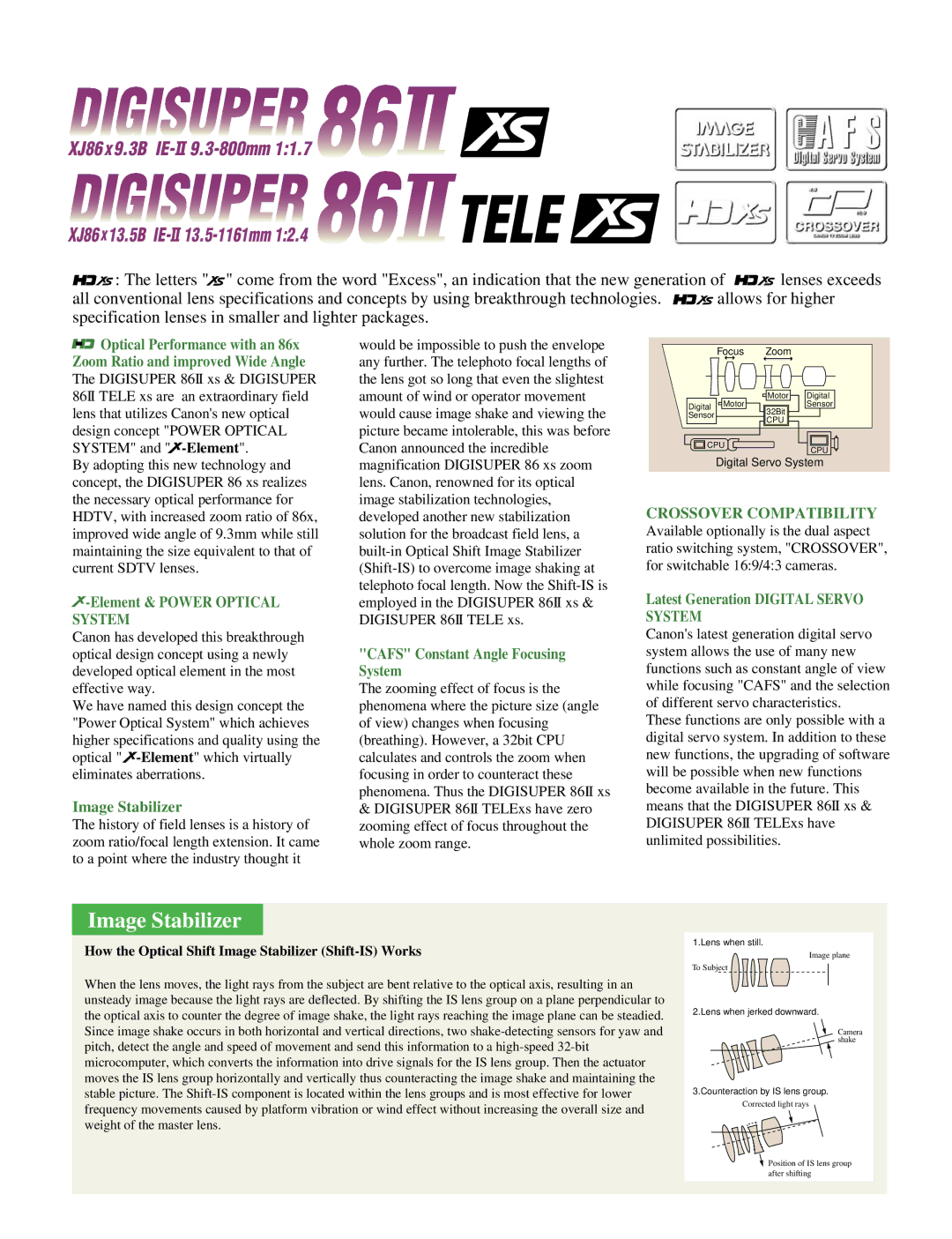
XJ86x9.3B
XJ86x13.5B | TELE |
|
![]()
![]() : The letters "
: The letters "![]() " come from the word "Excess", an indication that the new generation of
" come from the word "Excess", an indication that the new generation of ![]()
![]() lenses exceeds
lenses exceeds
all conventional lens specifications and concepts by using breakthrough technologies. ![]()
![]() allows for higher specification lenses in smaller and lighter packages.
allows for higher specification lenses in smaller and lighter packages.
![]() Optical Performance with an 86x Zoom Ratio and improved Wide Angle
Optical Performance with an 86x Zoom Ratio and improved Wide Angle
The DIGISUPER 86II xs & DIGISUPER 86II TELE xs are an extraordinary field lens that utilizes Canon's new optical design concept "POWER OPTICAL SYSTEM" and "
By adopting this new technology and concept, the DIGISUPER 86 xs realizes the necessary optical performance for HDTV, with increased zoom ratio of 86x, improved wide angle of 9.3mm while still maintaining the size equivalent to that of current SDTV lenses.
 -Element
-Element
Canon has developed this breakthrough optical design concept using a newly developed optical element in the most effective way.
We have named this design concept the "Power Optical System" which achieves higher specifications and quality using the optical ![]() -Element"
-Element"
Image Stabilizer
The history of field lenses is a history of zoom ratio/focal length extension. It came to a point where the industry thought it
would be impossible to push the envelope any further. The telephoto focal lengths of the lens got so long that even the slightest amount of wind or operator movement would cause image shake and viewing the picture became intolerable, this was before Canon announced the incredible magnification DIGISUPER 86 xs zoom lens. Canon, renowned for its optical image stabilization technologies, developed another new stabilization solution for the broadcast field lens, a
"CAFS" Constant Angle Focusing System
The zooming effect of focus is the phenomena where the picture size (angle of view) changes when focusing (breathing). However, a 32bit CPU calculates and controls the zoom when focusing in order to counteract these phenomena. Thus the DIGISUPER 86II xs
&DIGISUPER 86II TELExs have zero zooming effect of focus throughout the whole zoom range.
| Focus | Zoom |
|
| Motor | Motor | Digital |
Digital | 32Bit | Sensor | |
Sensor |
|
| |
| CPU |
| |
|
|
|
CPU
CPU
Digital Servo System
CROSSOVER COMPATIBILITY
Available optionally is the dual aspect ratio switching system, "CROSSOVER", for switchable 16:9/4:3 cameras.
Latest Generation DIGITAL SERVO SYSTEM
Canon's latest generation digital servo system allows the use of many new functions such as constant angle of view while focusing "CAFS" and the selection of different servo characteristics.
These functions are only possible with a digital servo system. In addition to these new functions, the upgrading of software will be possible when new functions become available in the future. This means that the DIGISUPER 86II xs & DIGISUPER 86II TELExs have unlimited possibilities.
Image Stabilizer
How the Optical Shift Image Stabilizer (Shift-IS) Works
When the lens moves, the light rays from the subject are bent relative to the optical axis, resulting in an unsteady image because the light rays are deflected. By shifting the IS lens group on a plane perpendicular to the optical axis to counter the degree of image shake, the light rays reaching the image plane can be steadied. Since image shake occurs in both horizontal and vertical directions, two
1.Lens when still.
Image plane
To Subject
2.Lens when jerked downward.
Camera shake
3.Counteraction by IS lens group.
Corrected light rays
Position of IS lens group after shifting
